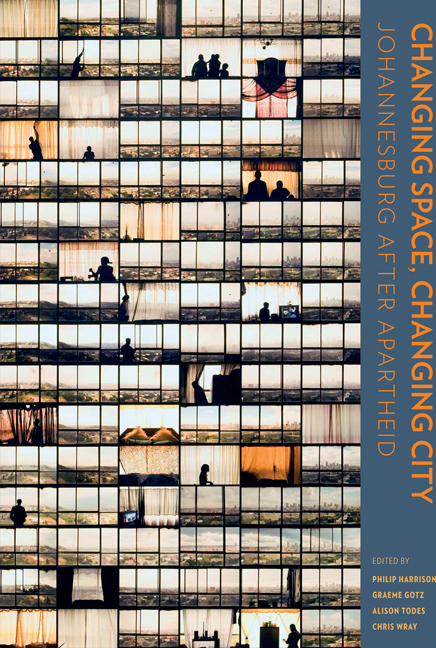Book contents
- Frontmatter
- Contents
- Preface
- Cartography
- 1 Materialities, subjectivities and spatial transformation in Johannesburg
- Section A The macro trends
- 2 The ‘thin oil of urbanisation’? Spatial change in Johannesburg and the Gauteng city-region
- 3 Poverty and inequality in the Gauteng city-region
- 4 The impact of policy and strategic spatial planning
- 5 Tracking changes in the urban built environment: An emerging perspective from the City of Johannesburg
- 6 Johannesburg's urban space economy
- 7 Changes in the natural landscape
- 8 Informal settlements
- 9 Public housing in Johannesburg
- 10 Transport in the shaping of space
- 11 Gated communities and spatial transformation in Greater Johannesburg
- Section B Area-based transformations
- Section C Spatial identities
- Contributors
- Photographic credits
- Acronyms
- List of plates
- List of figures
- List of tables
- Index
6 - Johannesburg's urban space economy
from Section A - The macro trends
Published online by Cambridge University Press: 20 April 2018
- Frontmatter
- Contents
- Preface
- Cartography
- 1 Materialities, subjectivities and spatial transformation in Johannesburg
- Section A The macro trends
- 2 The ‘thin oil of urbanisation’? Spatial change in Johannesburg and the Gauteng city-region
- 3 Poverty and inequality in the Gauteng city-region
- 4 The impact of policy and strategic spatial planning
- 5 Tracking changes in the urban built environment: An emerging perspective from the City of Johannesburg
- 6 Johannesburg's urban space economy
- 7 Changes in the natural landscape
- 8 Informal settlements
- 9 Public housing in Johannesburg
- 10 Transport in the shaping of space
- 11 Gated communities and spatial transformation in Greater Johannesburg
- Section B Area-based transformations
- Section C Spatial identities
- Contributors
- Photographic credits
- Acronyms
- List of plates
- List of figures
- List of tables
- Index
Summary
Concern is growing that the space economies of South Africa's cities are becoming more unequal, exacerbating historical racial and income divisions and/or generating new forms of spatial inequality (Sinclair-Smith and Turok 2012). Patterns suggested in the literature include: the economic marginalisation of former townships once reserved for black people (Naude 2008); the dispersal of economic activities (particularly office and commercial) from central cities to suburban locations (Beavon 2006; Goga 2003; Rogerson 1997); the development of new economic centralities on the periphery, but close to higher-income residential areas (see Chapter 18); and shift s in industrial location, with the decline of old manufacturing areas and the growth of new industrial spaces (Rogerson 2000). These patterns reflect socio-spatial changes noted internationally (e.g. Hall and Pain 2006), including the restructuring of economies and of particular economic sectors with globalisation, but particularly South African and city-specific dimensions are evident too (Sinclair-Smith and Turok 2012).
While strategic metropolitan spatial plans have hoped to restructure South African cities spatially to redress spatial inequalities, and there has been some success at the level of redistributing public investment, they have had little impact on the space economy. This is in part because the dynamics of urban space economies have been insufficiently understood and addressed by planning (Harrison et al. 2008; Todes 2008).
There is little systematic analysis of the performance of the Johannesburg economy or its space economy. Work that does stand out is that by Owen Crankshaw, Chris Rogerson and Wim Naude (2008). Indicatively, Crankshaw (2008) and Crankshaw and Parnell (2004), using historical Census data on employment by sector, trace the growth of Johannesburg manufacturing through the mid 1900s, and its dramatic collapse after 1980. Over the years Rogerson has analysed various sectors of the local economy. Representatively, his 2000 analysis of manufacturing uses data from the Bureau for Market Research Industrial Registers to show, for example, that while manufacturing has continued to shed jobs, the number of industrial establishments has held steady, and that in fact the northern parts of Johannesburg have seen a ‘remarkable industrial surge’ (2000: 317). Naude (2008) builds from the American scholarship that seeks to determine whether unemployment rates in African American communities can be attributed to poor spatial access to jobs (Gobillon et al. 2007).
- Type
- Chapter
- Information
- Changing Space, Changing CityJohannesburg after apartheid, pp. 117 - 136Publisher: Wits University PressPrint publication year: 2014



